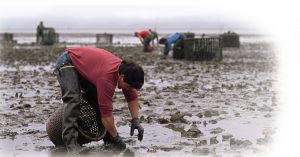January 27, 2021
National Sea Grant awarded $4.7 million total to strengthen the economics of the U.S. aquaculture industry

Workers for the Jolly Roger Oyster Company harvest oysters buried in the muddy bottom of Willapa Bay in Washington.
Washington Sea Grant (WSG) has been awarded $376,990 in federal funding for a project to collect and analyze data that will assist in sustainable shellfish aquaculture management and development. This is one of 12 research projects selected by the National Sea Grant College Program to advance the understanding of the economics of aquaculture businesses and provide the industry with important market information to aid sustainable growth in the U.S.
Led by Bobbi Hudson, executive director of The Pacific Shellfish Institute, the WSG project will collaboratively track shellfish aquaculture production in Washington state. Kevin Decker, coastal economist at WSG, will also contribute.
Project description: Through accurate quantification and valuation of Washington’s shellfish industry, support can be realized toward the productivity and economic sustainability of the industry and advance the U.S. Department of Commerce’s goal of growing domestic aquaculture. West Coast shellfish production is of interest because farm gate value exceeds $128 million and accounts for two-thirds of all oyster, mussel, and clam aquaculture sales in the United States (Northern Economics 2013). Bivalves also provide cultural value, recreation, food, jobs, and revenue for coastal regions, often in communities that are experiencing retraction of natural resource-based economies. Information collection and data visualization tools to assist sustainable shellfish aquaculture management and development is the focus of this proposed project, which is a “win-win” for shellfish managers and the shellfish aquaculture industry. The project will include the following five objectives: 1) Determine Washington State shellfish production information needs for public health requirements, state reporting requirements, and economic contributions and impacts. 2) Develop, through stakeholder and agency engagement, data collection protocols, the data portal, and multi-agency access for production information. 3) Survey selected shellfish farms to calculate the relative cost of materials and labor involved in various bivalve shellfish growing practices. 4) Conduct regional shellfish aquaculture production and value analysis, utilizing current data and updating a 2015 Washington Sea Grant report. 5) Develop an online “economic dashboard” for the output of objective four. Outputs will be useful for ongoing economic analysis, business planning, marketing efforts, public health compliance, as well as shellfish disease and pest risk management and response.
In addition, Decker will contribute to a project led by Connecticut Sea Grant to conduct business and economic planning for seaweed aquaculture systems in the U.S. This project received $766,650 in this funding.
Project description: Kelp (Saccharina spp.) are the most common seaweed species cultivated in the United States. Kelp farming, as well as the farming of various other seaweeds, is a significant and growing industry in the U.S. as seaweeds, especially kelp, can be used for food, medicinal products, additives and bioremediation. With any new industry, barriers to its development and expansion always emerge. One of the greatest barriers is the lack of economic/financial information on the cultivation of domestic kelp. There is a need to better understand the realistic economic and financial parameters associated with kelp aquaculture in order for farmers, investors and lenders to make more informed decisions regarding investment in this type of venture. The goal of this project is to support the development of a vibrant, profitable and sustainable seaweed aquaculture industry in the U.S. Project objectives include: (1) Develop business planning and management tools for kelp aquaculture systems, which improve the economic and financial viability of this industry; (2) Increase access to capital among existing and prospective seaweed farmers via an emphasis on improved industry knowledge for investors/financers/
The goals of the National Sea Grant funding opportunity are:
- Support broad, non-proprietary research to address critical gaps with respect to aquaculture economics and market needs;
- Make that information available to U.S. aquaculture businesses and management agencies; and
- Build the capacity of Sea Grant and its partners, including Sea Grant aquaculture extension personnel and industry stakeholders.
The selected projects will develop business management and planning tools and conduct economic and market assessments across multiple aquaculture sectors and geographies.
Download a full list of funded projects and descriptions here.
These investments are consistent with Sea Grant’s focus area of Sustainable Fisheries and Aquaculture (SFA) and the Sea Grant Network’s 10-year Aquaculture Vision, both which support NOAA and Department of Commerce aquaculture goals.
The grant recipients must match 50 percent of their funding with non-federal funds. For this funding opportunity, NOAA Sea Grant received 41 full proposals meeting minimum submission requirements that requested over $17 million in federal funds.
The economic benefit of Sea Grant’s investment in aquaculture in 2019 was $80 million, including sustaining or creating 1,052 jobs and 408 businesses. In 2020, Sea Grant employed or partially funded 111 professionals working on aquaculture around the country to study, communicate, identify needs or transfer research to industry members and the public.
The U.S. currently imports 85% of its seafood, resulting in a $14 billion trade deficit (NOAA). As seafood consumption continues to rise, wild-caught fisheries alone cannot meet the seafood demands of the U.S. population. NOAA, and its Sea Grant partners, are committed to advancing U.S. aquaculture in informed, sustainable and properly regulated ways.
Read more on Sea Grant’s “Relief that Restores” aquaculture work as well as the 2020 update on Sea Grant’s aquaculture investments. Additionally, see some of the impacts resulting from Sea Grant-funded aquaculture researchand learn more about aquaculture in the U.S.
JAN
2021